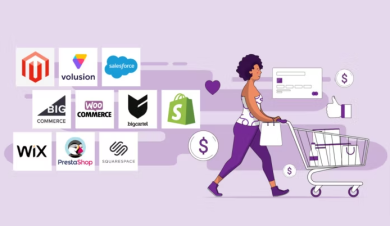B2B e-commerce is gaining traction.





Supporting B2B buyers and purchasers who grew up with the internet and the digital age is more likely than ever before.
A streamlined B2B order management procedure is crucial for pleasing this new group of purchasers.
It's Hard to Make a Smooth Sale When Selling to Other Businesses
Online business-to-business transactions are typically more involved than consumer transactions.
The normal buying cycle is typically much longer, and they typically demand more sophisticated technology like punchouts, RFPs, and EDI.
However, with the help of online order management software, best-practice procedures, and a well-thought-out strategy, your company may increase its operational efficiency while also overcoming the obstacles typically seen in B2B order management.
Commercial Order Processing
Business-to-business (B2B) order management refers to the procedures involved in keeping tabs on orders placed by customers and coordinating their fulfillment.
The steps involved in managing an order placed between businesses often include:
After receiving an order from a customer, your sales rep enters the details into the appropriate order tracking system (e.g., an automated program, an enterprise resource planning system, or just some old-fashioned spreadsheets).
If you run a business-to-business (B2B) ecommerce operation, this initial step can be bypassed entirely by having your client place an order directly with you online. This can be done through a specialized B2B ecommerce platform, such as BigCommerce, or through a bespoke client portal.
The customer receives a confirmation of their order.
Products are set aside and assigned to orders (either by hand or by computer).
If there are any goods on the order that are currently out of stock, a back order will be created and the order will be submitted to the warehouse for fulfillment.
Customers are notified through email after their order has been shipped.
The consumer has accepted delivery of their order.
The process of managing orders also includes keeping tabs on and processing any related returns, exchanges, or refunds.
For starters, what exactly is an Order Management System?
Any system that allows for the centralized management and monitoring of orders, stock levels, and shipments is considered to be an order management system.
Though we'll go over all of your options in detail later on, here are the five most frequent kinds of order management systems:
Which is the backbone of your online store.
Spreadsheets.
Separate program for handling orders.
Accounting and inventory management in one streamlined package; often known as "ERP" software.
Hardware and software for B2C and B2B trade.
Problems with a Business-to-Business Order Management System
As was previously said, the increasing prevalence of business-to-business ecommerce has raised expectations while introducing new layers of complexity to the purchasing and selling process.
Here are some of the most typical problems that B2B companies encounter nowadays.
One, the complexity and expansion of global supply chains.
There are now a plethora of options for completing orders and sending packages all over the world, from traditional in-house supply chain procedures to third-party logistics (3PL) providers and dropshipping businesses.
Working with a 3PL entails sending frequent shipments of stock to your logistics provider, who then ships out orders, processes returns, forwards freight, and sometimes even processes orders, depending on the service package you agree upon with them.
Orders and shipments are forwarded to a supplier or producer upon request in dropship fulfillment. Your clients won't know you're using a dropshipping company because the products will be shipped with your branding intact and delivered directly to them.
However, Electronic Data Interchange stands out as a supply chain strategy that introduces novel difficulties and complications for B2B organizations (EDI).
EDI enables electronic document and transaction interchange between trading partners.
Customers can send you a purchase order electronically through EDI instead of using the mail or a fax machine.
Larger corporations like Target, Walmart, and Tesco, whose buyers you hope to attract, will demand that your systems be interoperable with theirs so that they can place and fulfill orders with minimal duplication of effort.
Thankfully, there are a plethora of firms available that focus on EDI connectors for both your online shop and your order management software, simplifying the process significantly. SPS Commerce, B2B Gateway, and Arizon Digital Intelligent Solutions are just a few of the market's top providers.
The rise of e-commerce and the importance of multichannel retailing.
Increasing the volume of online orders can impose a strain on a company's operations, especially if those operations are slow and inefficient.
However, this is also a common area for inventory discrepancies to develop, especially if your systems and processes don't allow for real-time inventory updates across all of your channels.
Further, "two-speed order fulfillment" is essential if your organization is a mix of retail and business-to-business transactions.
Because of this, you'll have to deal with a mix of larger orders that come less frequently and smaller orders that come more frequently, as well as manage different lead times for your business-to-business and business-to-consumer clients.
Buyers have high expectations.
As a general rule, B2B clients have far greater expectations than B2C customers, as they are more likely to be placing larger and more value purchases with you and are seeking for a long-term supplier to do repeat business with.
Millennials make up a sizable portion of B2B customers, and they expect the same conveniences and high standards of service that they enjoy when shopping for consumer goods.
In addition to face-to-face interactions with salespeople, most consumers place a premium on good deals, individualized service, and streamlined order placement.
Your company must be able to meet these rigorous standards. If you don't, you run the danger of losing contract cancellations and chargebacks from your most valuable business-to-business clients.
Here is when having an effective order management system and an e-commerce platform that has built-in support for your specific industry come in handy.
The requirements of businesses are different from those of consumers.
Your business-to-business customers have varying requirements, just as they do varying levels of familiarity with your company and its procedures.
A minimum of two of the following conditions must be met:
Direct communication and direction when traveling.
Wholesale pricing is available.
Specialized pricing plans.
Expected and delayed shipments.
Different credit periods and payment methods are available, including proforma invoices, deposits, split payments, and payments on account.
Fulfillment strategies including dropshipping, partial fulfillment, and simultaneous orders are available.
Ordering and tracking can be done easily and quickly online.
Constant contact and individualized updates.
Reasons Why You Should Use Business-to-Business Order Management
Effective B2B order management solutions can help you overcome these difficulties by handling the repetitive, mundane tasks so that you have more time to focus on exceptions and front-of-house strategy.
First, coordinate purchases across all channels.
The best B2B order management systems let you incorporate multichannel or even omnichannel approaches into your operations.
This implies you can take orders from clients regardless of where they are shopping and then process them according to your own internal procedures.
This will cut down on the time spent by both you and your customers on routine tasks like inventory management, order creation, and payment processing.
You will be able to simply keep track of all of your B2B orders, regardless of whether they were placed online, over the phone, through EDI, or in person.
In addition, if you run a firm that caters to both B2B and B2C consumers, your systems should be able to track sales made through channels other than just online stores.
2) Start using digital documents instead of paper ones.
Most order processing software of today operates on the cloud.
As much as 67% of company IT will be hosted in the cloud by 2020.
The widespread adoption of cloud computing is largely due to the fact that it facilitates paperless office operations.
As a result, you can reduce your company's environmental impact and boost productivity by having all of your information accessible online at any time, from any location.
You can eliminate the use of snail mail, fax machines, and handwritten correspondence by switching to a cloud-based system.
Instead, you can contact with customers and take orders using email and specialized web platforms.
In addition to helping the environment, cutting down on paper use would save up money that would have gone into things like paper, ink, and toner.
Third, consolidate data from several sources into a single hub.
All of your B2B orders and stock levels may be managed from a single dashboard, regardless of whether your clients make purchases from you digitally, in person, over the phone, or via electronic data interchange (EDI).
No matter how or where your consumers place their orders, you can rest assured that they will be supported by accurate, consistent, and dependable data.
4. Reduce supply chain complexity.
By keeping track of orders and stock levels in one place, you can keep tabs on your inventory with much less effort.
From when an order initially comes in, to picking, packaging and shipping, you’ll simply be able to track those orders and remark on the current progress of each one.
And not just your own warehouses and retail outlets, but also those of any 3PLs you work with or marketplace fulfillment centers like Amazon's.
5 Maintain order status and client satisfaction.
If you can keep track of orders efficiently, you'll have a higher chance of satisfying your clientele.
Customers may be assured that no matter who they speak with in your company, they will receive timely information regarding the status of their purchases or the ability to make changes to an existing order or invoice.
You can save time and money, as well as enhance the quality of service you provide to customers, by using technology to distribute the load of mundane but essential tasks like order management, fulfillment, and inventory updates.
Sixth, accommodate specific needs of customers through customization.
It's to be expected that the standards of your business clients are high.
Unless your product or service is extremely specialized, B2B customers often place orders that are far larger and more valuable than those placed by B2C customers.
Differentiating your business from the competition can be accomplished in part by continuously improving the quality of the experience and service you provide to each and every one of your consumers.
Each customer's order fulfillment, shipping, invoicing, payment methods, and sales channels can be modified with the help of an advanced order management system.
Seven, obey direct spoken commands.
We've already established that your B2B clients have distinct needs from your B2C clientele.
The requirement to issue directives during in-person conferences is one such circumstance.
Taking orders on the go won't be a problem if you choose a cloud-based system that allows for offline mode.
8 Please expedite the shipping of orders.
Managing B2B sales orders manually is a hassle for everyone involved.
Order allocation, fulfillment, warehouse routing, shipping status updates, inventory checks, and more may all be automated with the help of a smart order management system.
It will help you ship orders out and send them to clients more quickly and cheaply.







